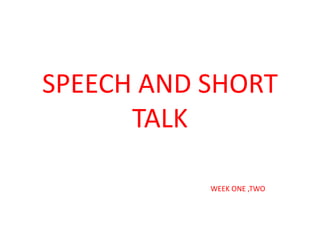
Speech
- 1. SPEECH AND SHORT TALK WEEK ONE ,TWO
- 2. INSTRUCTIONS TO DELIVERING AN EFFECTIVE SPEECH • Organize the topic. Without a clear road down which to take an audience, the message will get lost. Once you have a topic and a purpose (whether that purpose is to inform, persuade or entertain), the beginning step must be to organize the information you've gathered into a good outline. That outline will include a clear thesis, good points that support the thesis, and specific stories or other evidence to flesh out each point
- 3. • Introduce your speech. • interact with the audience, develop credibility on the subject matter and grab the audience's attention. Tell the audience why they need to know about your topic. Then deliver the thesis of the speech, the overriding theme of what you'll discuss through your points.
- 4. • Pay attention to performance. • Standing at a podium without movement or reading a speech from note cards does not lead to an effective speech. • Use movement to keep the audience's attention, but make those movements and gestures purposeful. • Also, alter voice volume, tone, speed and inflection to emphasize pieces of your speech. Always be sure your clothing is appropriate for the speech being given.
- 5. • Establish a time frame for the speech. Just because you are given 30 minutes to make the speech, that does not mean you have to take the entire amount of time. Use only the time needed to deliver a solid presentation. • Do your research. Even if the speech topic is something with which you are familiar, do not assume you have all of the answers. Research to bring in new angles or to update statistics. • Outline the main points of the speech. As a minimum, an outline should contain the introduction, body, conclusion and call to action, if appropriate. • Determine how to open the speech. Consider posing a question, stating a shocking statistic or citing a famous quote. It is imperative to get the audience's immediate attention. If you lose them at the beginning, it is often hard to get them back. Do not forget to thank those who invited you and the audience you are addressing. • Consider giving a synopsis of the areas you will cover. If this information can be handed out rather than delivered verbally, that often works better. But if not, it is a good idea to let the audience know where you are going with your remarks.
- 6. • Choose verbiage that is at the level of the average audience member. There is nothing that people hate more than speakers who attempt to speak over their heads. You will lose them right away and undermine the valuable knowledge you might have to share. • Hit points that are important to the audience. For example, if you are delivering a political speech, speak about the topics that are important to the public at the time. • Back up what you say. Never make wild accusations or state statistics that cannot be verified. Make notes on everything. This will be important in the event that questions are asked. Always have your references at hand. • Write, rewrite, and rewrite again if necessary. Practice the speech out loud between rewrites until you are happy with the way it flows and how you present it. Consider making notes or cue cards to use during the presentation. • Wrap up the topic. Again, think about delivering a startling fact, a famous quote or even a call to action. The end of the speech is just as important as the beginning.
- 7. How to begin a speech • *Be dramatic. Say something like, "I'm about to reveal a plan that will drastically alter the face of humanity as we know it!" when your presentation is really about a new brand of facial soap. *Tell a joke. Getting people to laugh will loosen them up and make them feel inclined to like you and hear what you have to say. Don't try this if your jokes are usually met by silence or groans. Test out your opening on your most brutally honest of friends. *Tell a story. This will make the audience see you as a person instead of a boring public speaker, thus giving you an air of accessibility. just keep the story short (under 1 minute) and relevant to the rest of your presentation. *Pose a question. Asking audience members for their input will make them feel involved, even if you're going to answer your own question.
- 8. BODY OF A SPEECH *Use a formal outline. • outlining your major points with numerals. • two or three main points, each of which has a couple of sub-points or examples. • Formally outlining your speech will ensure that your logical flow makes sense and that your audience doesn't get lost. *Mind-map.. Instead of making a list, you write the main topic of your speech in the center of a piece of paper, then draw branches extending from it that highlight your key points.. However you create your body, the key point is that you are organized. The audience must be able to follow your thoughts.
- 9. CLOSURE • The closing-- sum up everything in a few concise sentences and leave them with a witty line. If appropriate, also ask for questions.